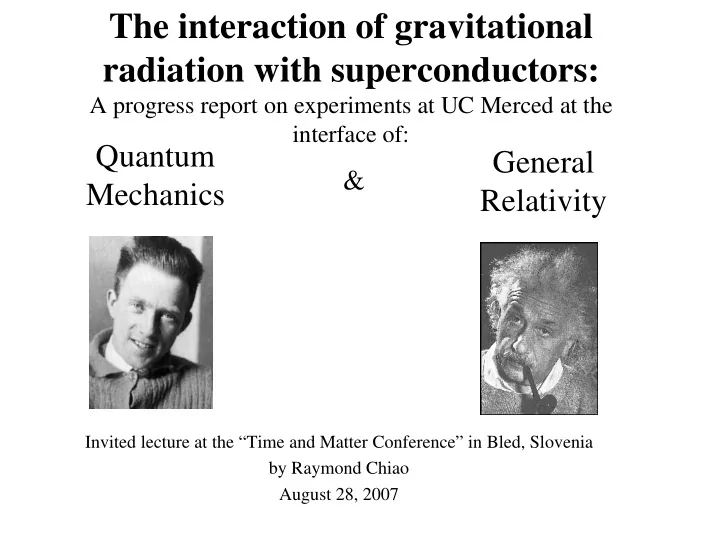

The interaction of gravitational radiation with superconductors: A progress report on experiments at UC Merced at the interface of: Quantum General & Mechanics Relativity Invited lecture at the “Time and Matter Conference” in Bled, Slovenia by Raymond Chiao August 28, 2007
Co-workers • Students: S. Minter, J. McLane • Collaborators: C. Rowe, K. Wegter- McNelly* *Work sponsored by the Center of Theology and Natural Sciences STARS program
Hoover dam is an efficient hydroelectric energy converter of: Gravitational energy � electrical energy
Can we convert gravitational wave energy efficiently into electromagnetic wave energy? Answer: YES
What is a gravitational wave? • It is a time-varying tidal gravitational field (think of jello with grapes embedded inside it)
Tidal forces of a gravitational wave 5 g 4 3 2 1 0 c. m. -1 -2 -3 -4 -5 -5 -4 -3 -2 -1 0 1 2 3 4 5
One possible GR-to-EM wave converter Levitated superconducting sphere B B d(t) I Ring with supercurrent I
Levitated superconducting sphere B B d(t) I Ring with supercurrent I
Faraday’s law leads to high conversion efficiency for superconductors Lenz’s law implies that: = − F F GR EM ⋅ ∴ = F v Power absorbed from GR wave GR rad ⋅ = − = F v Power emitted into EM wave. EM rad
Similarly, in the time-reversed process of EM-to-GR wave conversion = − F F EM GR ⋅ ∴ = F v Power absorbed from EM wave EM rad ⋅ = − = F v Power emitted into GR wave. GR rad
Wave conversion from gravitational to EM wave out electromagnetic waves transducer Quantum GR wave in
B superconducting supercurrent I Ring with Levitated d(t) sphere I Example: B
EM wave in Time-reversal symmetry transducer Quantum GR wave out
Hertz-like experiment Quantum transducer EM wave in GR wave EM wave out Quantum transducer
Einstein's field equations π 8 G − = 1 R g R T μν μν μν 2 4 c ≈ η + For weak fields, g h μν μν μν ⎛− ⎞ 1 0 0 0 ⎜ ⎟ ⎜ ⎟ 0 1 0 0 η = << η where and h . ⎜ ⎟ μν μν μν 0 0 1 0 ⎜ ⎟ ⎜ ⎟ ⎝ ⎠ 0 0 0 1 = = = Then in the transvers e - traceless gauge ( h h h 0 ) μ 0 ij , j kk ∂ 2 π h μν 1 16 G ∇ 2 − = − h T μν μν 2 ∂ 2 4 c t c
Maxwell-like equations for weak gravitational fields ρ ∇⋅ = − = G E where E g ε G G G ∂ B ∇× = − ∂ G E G t ∇⋅ = B 0 G ∂ ⎛ ⎞ E ∇× = μ − + ε G ⎜ ⎟ B j ∂ G G G G ⎝ ⎠ t
where π 16 G − μ = = × 30 3.7 10 SI units G 2 c 1 ε = = × 9 1.19 10 SI units π G 4 G
Gravity wave speed and impedance 1 = = × 8 c 3.00 10 meters/sec ε μ G G μ − = = × 18 G Z 2.79 10 SI units ε G G
Why quantum mechanics? • Efficiency of quantum transducers depends on “quantum rigidity” • Efficiency of quantum gravity wave antennas depends on “quantum dissipationlessness” • Both arise from the ENERGY GAP (e.g, the BCS gap) of the quantum system and the quantum adiabatic theorem.
Energy gap of a two-level quantum system Excited state ENERGY GAP Ground state
What’s the difference between a normal metal and a superconductor? normal superconductor metal � � ω ω � � � � magnetic field = ω m B = created by B 2 e 0 e London moment
Reflection of a gravitational plane wave from a normal metal vs. a superconductor superconductor normal metal in the presence of in presence of gravito-magnetic field gravito-electric field � � B G g v=0 � -2e +Ze s G -e +Ze -2e +Ze cm v=0 -e +Ze � ⊗ B G - g � � � = 1 ( × s E B ) μ G G G G
An important application: “Gravity Radio” • Intercontinental communication by microwave-frequency gravity waves directly through the interior of the Earth
Gravity waves from the Big Bang Cosmic Gravitational Wave Background (CGB) Slow-Roll Inflationary Big Bang 0 Ekpyrotic/Cyclical Model Pre-Big Bang Model Advanced LIGO/VIRGO Sensitivity (ground-based) Fractional Energy Density [Log 10 h 02 Ω gw ] LISA Sensitivity (space-based) Planck Sensitivity (space-based, indirect EM measurement) -5 Big Bang Observer (space-based, LISA follow-on) 0.9 K Thermal Spectrum (Wien peak f = 53 GHz) -10 -15 -20 -20 -15 -10 -5 0 5 10 15 Frequency [Log 10 f(Hz)]
CONCLUSIONS: • A pair of superconducting bodies can become an efficient transducer between GR and EM waves. • Observations of “Cosmic Gravitational-wave Background” (CGB) should be possible. • “Gravity radio” communications between continents should be possible.
Recommend
More recommend